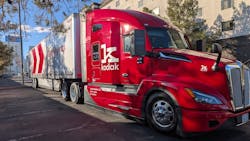Autonomous trucking in 2025: Supply chain transformation on the horizon
Key takeaways:
- Gradual advancements are being made in autonomous trucking, particularly in controlled environments, with human drivers still essential for handling unpredictability.
- As driver assistance technologies enhance safety and productivity, autonomous trucking is improving supply chain efficiency without eliminating jobs.
- New liability questions are emerging alongside fragmented regulations and a need for improved connectivity infrastructure to support autonomous vehicle operations.
The transportation industry is making consistent, step-by-step advancements toward fully autonomous trucking. While there’s real progress happening, especially in small-scale, local self-driving applications and even in some long-haul segments, we’re still a ways out from tractor-trailers officially cruising down highways without a human in the cab.
What may be even more significant than the technological milestones to date are the business model implications—and how those could reshape labor markets and the broader logistics sector.
Where autonomy stands today
Progress is happening incrementally. We’re seeing notable improvements in closed environments such as distribution yards and ports, as well as in urban delivery settings where frequent stops are the norm. Long-haul trucking is also evolving, with reductions in safety incident rates and a growing shift from driver-led to supervisor-monitored journeys.
Autonomous vehicles, when properly deployed, tend to have fewer accidents than human-operated ones. This changes the nature of the human role in the cab, making drivers essential fallback mechanisms. Keeping a human in the cab allows for broader coverage of unpredictable situations, and for the foreseeable future, that presence remains critical.
A reimagined supply chain
Rather than posing a sudden disruption to the transportation and logistics industries, autonomous trucking represents a continuation of the gradual innovation we’ve seen in supply chains over generations. For decades, we’ve improved shipment speed, reliability, and cost efficiency—not through singular breakthroughs, but by steadily pushing the boundaries of technology and implementation.
This natural evolution aligns with the introduction of driver assistance technologies over the past decade. For instance, the Insurance Institute for Highway Safety conducted research showing that rear automatic braking systems, when combined with rearview cameras and parking sensors, can reduce backing crash-involvement rates by more than 75%. Technologies like Trimble CoPilot guide drivers along optimal routes. When drivers aren't preoccupied with wayfinding, they stay more alert, avoid errors, and work more efficiently. These improvements often stem not from bleeding-edge new tech but from applying proven solutions more rigorously and at greater scale.
What we’re likely to see isn’t the elimination of labor, but a steady increase in throughput per labor hour, according to the U.S. Bureau of Labor Statistics. This kind of evolution benefits everyone, rather than disrupting the entire industry.
Liabilities, regulations, and infrastructure
Autonomous vehicles are statistically safer per mile driven, which should reduce overall societal safety risk on the road. However, the risk profile itself shifts with technological advancement. For example, it's highly unlikely that 100 human drivers would all experience a failure simultaneously. But 100 autonomous vehicles could potentially be affected all at once by a cyberattack or software glitch.
This raises never-before-asked questions about liability. System vendors and trucking companies will likely need to share responsibility, but there’s currently a mismatch in appetite for risk. Many manufacturers are hesitant to accept large-scale liability, and trucking companies may be reluctant to shoulder it alone.
Regulations are also highly fragmented. Presently, each state sets its own rules, which has led companies to focus operations in states with more permissive environments or deploy technology in private settings, such as ports, mines, and agricultural operations, where public road regulations don’t apply as strictly.
Infrastructure needs are also shifting. For example, autonomous vehicles don’t require rest stops, overnight parking, or other roadside amenities like human drivers do. Instead, they demand robust, reliable connectivity—strong 5G networks or satellite internet backups. This is the real infrastructure transformation on the horizon.
See also: Autonomous trucking is more than autonomous trucks
Economies of scale in trucking
Full truckload trucking has historically lacked economies of scale. Unlike air freight, rail, or ocean shipping—industries where being bigger confers real advantages—FTL remains highly siloed.
Right now, autonomous vehicles don’t really alter that landscape. The rollout is slow, and the cost structure of operating an autonomous truck remains comparable to traditional operations.
Consider this: Whether you run 1,000 trucks or 10, filling the final one offers only a small advantage over a competitor that does not. There’s little difference in unit economics between a large and small fleet when it comes to incremental growth. That’s why we don’t see dominant players in FTL the way we do in other sectors.
However, if autonomous technology eventually eliminates the need for onboard human labor—particularly in long-haul scenarios—the unit economics could shift. We might then see the FTL market begin to resemble rail or ocean shipping, which are far more consolidated and benefit from scale.
The future of autonomous trucking
Autonomous trucking is already a reality in controlled environments like mines, airports, and large yards. But on public roads, fully autonomous transportation remains a distant goal.
Much of the progress depends on more than just technology. It’s the intersection of technological readiness, infrastructure updates, business model viability, and regulatory acceptance that will determine how and when autonomy scales.
Our teams are preparing for that intersection. Many of the foundational technologies in logistics are focused on bridging the gap between human behavior and digital systems. With autonomous vehicles, which are driven by software, that gap becomes easier to close.
Internally, our best approach is to anticipate and pay attention to how autonomous systems evolve and adapt our products accordingly. We’re watching closely: Will there be a dominant provider or multiple players? Will vehicles be long-haul focused or local? Centrally managed or individually owned? Our answers to these questions will shape how we support our customers moving forward.
The future isn’t arriving all at once. But those who are preparing today—by aligning their technology, infrastructure, and business models—will be best positioned to lead as autonomous trucking gradually becomes mainstream.
About the Author

Jonah McIntire
Jonah McIntire is the chief product and technology officer at Trimble. He joined Transporeon in June 2021 and quickly led a succession of larger product organizations in the sourcing & data insights areas of the company. Known for his broad international experience, having lived and worked in 13 countries, McIntire’s prior experience includes running global logistics for Build-a-Bear Workshop, launching business units for Manhattan Associates and Panalpina, and writing a university textbook on supply chain visibility.
